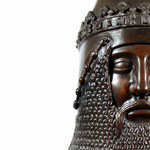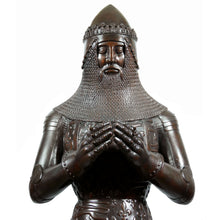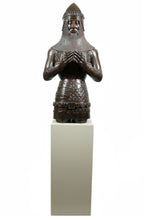The Black Prince - Edward, Prince of Wales (1330-76), Circa 1875
Adding product to your cart
Height: 119.4 cm (47in)
Life sized patinated copper electrotype. Made by the Birmingham firm of Elkington from a plaster cast mould taken by Domenico Brucciani (1815-1880) from the fourteenth century full-length effigy of the Black Prince in Canterbury Cathedral.
Read more
The only other known example stands sentinel at the entrance to the Tudor and Elizabethan Gallery.
of the National Portrait Gallery. The NPG version belongs to a group of figures commissioned by the Gallery between 1869 and 1881. In the absence of two-dimensional medieval portraits, they were created to represent some of the most charismatic and compelling members of the Plantagenet dynasty that ruled England for over three hundred years. The Gallery commissioned Domenico Brucciani, a former member of the faculty of the Royal College of Art, to make plaster casts of important original tombs in Westminster Abbey, Gloucester Cathedral and Canterbury Cathedral. From these casts electrotype sculptures were made by the Birmingham firm of Elkington & Co. using the newly developed process of electroforming. National Portrait Gallery’s Black Prince was purchased in 1875 and forms part of the Primary Collection (NPG396).
Although Edward never became king - he died before his father, Edward III - he is remembered as a great medieval military hero, with notable victories against the French in the Hundred Years War.
Edward was born on 15 June 1330 at Woodstock in Oxfordshire, the eldest son of Edward III. He was created Prince of Wales in 1343. He showed military brilliance at an early age, playing a key role in the defeat of the French army at the Battle of Crecy when he was only 16. In 1355, he was appointed his father's lieutenant in Gascony and the following year led another significant victory against the French at Poitiers, taking the French king prisoner.
In 1362, Edward married Joan of Kent and was created Prince of Aquitaine and Gascony by his father. Edward and his wife went to live in his new French domains. In 1367, Edward led an expedition to Spain, to restore the deposed King Pedro of Castile, and proved himself again with victory at the Battle of Najera in northern Castile. Edward returned to Aquitaine, where he made himself unpopular with the nobility by levying taxes to pay for his Spanish expedition. They rose in revolt against him and in 1370 Edward besieged the city of Limoges. When it fell, 3,000 of its inhabitants were massacred. A year later, Edward returned to England. Edward died aged 45 on 8 June 1376, probably from an illness contracted in Spain, and was buried in great splendour in Canterbury Cathedral. His young son, Richard, succeeded Edward III a year later. During his lifetime he was known as Edward of Woodstock. The title of Black Prince developed after his death and may refer to black armour that he wore.
Domenico Brucciani (1815-1880) came to England from Lucca with his father and became the leading manufacturer and dealer in plaster casts in London. Having supplied the Government Schools of Design, British Museum and South Kensington Museum with casts, he opened a showroom near Covent Garden called the Galleria delle Belle Arti in 1864. Between 1853 and 1861, he was listed as a ‘Teacher of Moulding and Casting‘ at the Royal College of Art (& National art Training School). He described himself variously as a 'Modeller'; 'Professor of Modelling in Clay'; 'Plaster Figure Manufacturer Employing 25 Men & 5 Boys', and 'Artist'. His most substantial commission for the South Kensington Museum was the casting of the Pórtico de la Gloria, the 12th-century façade of the cathedral at Santiago de Compostela, in 1866. His obituary in The Builder offered the following endorsement: ‘Although chiefly a plasterman in calling, he was an artist at heart’. After his death, the business was purchased by a fellow Italian, Joseph Caproni (1846-1900), who retained the name D. Brucciani & Co.
Electrotyping was used by for the production of metal sculptures as an alternative to the casting of molten metal. It was possible to apply essentially any patina to these sculptures; gilding was also readily accomplished in the same facilities as electrotyping by using electroplating. Electrotyping has been used to reproduce valuable objects such as ancient coins, and in some cases electrotype copies have proven more durable than fragile originals.
One of the earliest documented large-scale (1.67 metres (5.5 ft)) electrotype sculptures was John Edward Thomas’s Death of Tewdric Mawr, King of Gwent (1849). The electrotype was produced by Elkington for the Great Exhibition of 1851. Other spectacular early examples of electrotypes include the twelve angels (1858) at the base of the cupola of Saint Issac’s Cathedral in St. Petersburg, the ‘bronzes’ that adorn the Palais Garnier (the Opera), Paris, and the 3.20 metres (10.5 ft) high statue of Prince Albert and four accompanying figures, erected behind the Albert Hall in London as a memorial to the Great Exhibition of 1851. The electrotyping process ‘was one in which the Prince Consort had great faith.’






